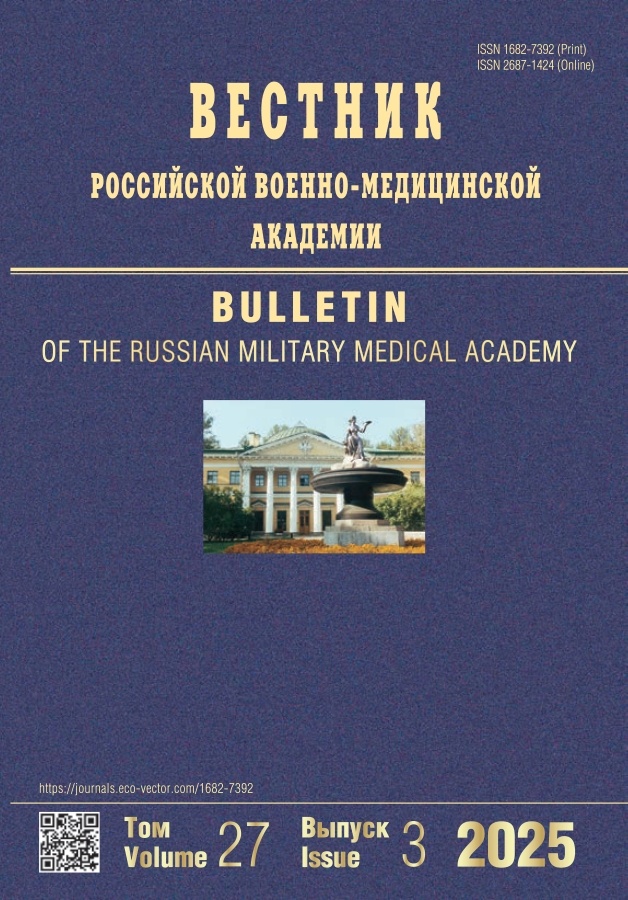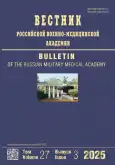Оценка тканеспецифичности влияния нейротоксикантов на метаболические процессы в различных органах лабораторных животных в фазе формирования отдаленных последствий тяжелых острых отравлений
- Авторы: Потапов П.К.1,2, Шустов Е.Б.1, Мельникова М.В.1, Золотоверхая Е.А.1, Кубарская Л.Г.1, Кузнецова Н.В.1, Шемаев М.Е.1, Башарин В.А.2
-
Учреждения:
- Научно-клинический центр токсикологии им. акад. С.Н. Голикова
- Военно-медицинская академия им. С.М. Кирова
- Выпуск: Том 27, № 3 (2025)
- Страницы: 375-383
- Раздел: Оригинальное исследование
- URL: https://bakhtiniada.ru/1682-7392/article/view/319569
- DOI: https://doi.org/10.17816/brmma649818
- EDN: https://elibrary.ru/GXCFVW
- ID: 319569
Цитировать
Аннотация
Обоснование. В настоящее время патогенез отдаленных последствий отравлений нейротоксикантами остается не до конца изученным. Тканеспецифичность как качественная характеристика действия токсиканта проявляется в избирательности перестройки метаболических процессов в клетках отдельных тканей.
Цель исследования — изучение тканеспецифичности изменений метаболизма в фазе формирования отдаленных последствий острых интоксикаций.
Методы. Экспериментальное исследование выполнено на крысах. В качестве токсикантов были использованы фенилкарбамат в дозе 1,6 мг/кг, метанол в дозе 11,5 г/кг, ацетат свинца в дозе 300 мг/кг. Определение показателей перекисного окисления липидов и антиоксидантной системы проводили, используя стандартные биохимические методики, на 30-й день после интоксикации.
Результаты. В группах интактных и выживших после интоксикации животных процессы перекисного окисления липидов и антиоксидантной системы характеризуются выраженной тканеспецифичностью. Установлено, что наиболее выраженное общее для тканей организма влияние токсиканты оказывают на содержание в тканях диеновых конъюгатов, так как после интоксикации степень тканеспецифичности существенно снижается. В отношении такого показателя активности перекисного окисления липидов, как тканевая концентрация малонового диальдегида, фенилкарбамат и свинец усиливают степень тканеспецифичности ответа на токсическое воздействие, что свидетельствует о наличии избирательного влияния на отдельные звенья оксидативного стресса в тканях.
Заключение. Показатели процессов перекисного окисления липидов и активность компонентов антиоксидантной системы могут рассматриваться в качестве маркерных для оценки влияния токсикантов на метаболические процессы в разных тканях. Более высокая чувствительность к токсическому воздействию ткани мозга проявляется в более высоком уровне роста диеновых конъюгатов (фенилкарбамат, ацетат свинца), глюкозо-6-фосфатдегидрогеназы и супероксиддисмутазы (метанол). Для печени тканеспецифичным ответом будет повышение активности глюкозо-6-фосфатдегидрогеназы (фенилкарбамат, метанол) при снижении активности супероксиддисмутазы (метанол, ацетат свинца). Для почек будет специфичным нарушение утилизации восстановленного глутатиона (метанол) или его образования (ацетат свинца). Маркером тканеспецифичного ответа ткани селезенки будет компенсаторная активация супероксиддисмутазы (метанол, ацетат свинца).
Полный текст
Открыть статью на сайте журналаОб авторах
Петр Кириллович Потапов
Научно-клинический центр токсикологии им. акад. С.Н. Голикова; Военно-медицинская академия им. С.М. Кирова
Автор, ответственный за переписку.
Email: vmeda-nio@mil.ru
ORCID iD: 0000-0002-4602-4468
SPIN-код: 5979-4490
канд. мед. наук
Россия, 192019, Санкт-Петербург, ул. Бехтерева, д. 1рг; Санкт-ПетербургЕвгений Борисович Шустов
Научно-клинический центр токсикологии им. акад. С.Н. Голикова
Email: vmeda-nio@mil.ru
ORCID iD: 0000-0001-5895-688X
SPIN-код: 9665-6670
д-р мед. наук, профессор
Россия, Санкт-ПетербургМаргарита Викторовна Мельникова
Научно-клинический центр токсикологии им. акад. С.Н. Голикова
Email: vmeda-nio@mil.ru
ORCID iD: 0000-0002-2996-5151
SPIN-код: 1296-2830
фармаколог
Россия, Санкт-ПетербургЕкатерина Андреевна Золотоверхая
Научно-клинический центр токсикологии им. акад. С.Н. Голикова
Email: vmeda-nio@mil.ru
ORCID iD: 0000-0002-9708-2596
SPIN-код: 8138-1497
канд. биол. наук
Россия, Санкт-ПетербургЛариса Георгиевна Кубарская
Научно-клинический центр токсикологии им. акад. С.Н. Голикова
Email: vmeda-nio@mil.ru
ORCID iD: 0000-0001-7622-0390
SPIN-код: 9596-7227
канд. биол. наук
Россия, Санкт-ПетербургНаталья Валерьевна Кузнецова
Научно-клинический центр токсикологии им. акад. С.Н. Голикова
Email: vmeda-nio@mil.ru
ORCID iD: 0009-0000-0876-9293
SPIN-код: 2336-3825
биохимик
Россия, Санкт-ПетербургМихаил Евгеньевич Шемаев
Научно-клинический центр токсикологии им. акад. С.Н. Голикова
Email: vmeda-nio@mil.ru
ORCID iD: 0000-0001-6062-0437
SPIN-код: 6612-3721
химик
Россия, Санкт-ПетербургВадим Александрович Башарин
Военно-медицинская академия им. С.М. Кирова
Email: vmeda-nio@mil.ru
ORCID iD: 0000-0001-8548-6836
SPIN-код: 4671-8386
д-р мед. наук, профессор
Россия, Санкт-ПетербургСписок литературы
- Kostrova TA. Experimental evaluation of changes in neurotrophic and apoptotic factors in the implementation of long-term consequences of acute severe poisoning by sodium thiopental. Toxicological Review. 2019;(5):49–53. doi: 10.36946/0869-7922-2019-5-49-53 EDN: MRHJDT
- Vasiliev SA, Livanov GA, Batotsyrenov BV. Features of intensive care organization for severely ill patients with acute poisonings. Medical Alphabet. 2013;2(14):49. EDN: RMXMYL
- Kutsenko SA. Fundamentals of toxicology. Saint Petersburg: Foliant; 2004. 715 p. (In Russ.)
- Ku J, Asuri P. Stem cell-based approaches for developmental neurotoxicity testing. Front Toxicol. 2024;6:1402630. doi: 10.3389/ftox.2024.1402630
- Luzhnikov EA, Sukhodolova GN. Acute poisoning in adults and children. Moscow: Eksmo; 2009. 556 p. (In Russ.)
- Shustov EB, Melnikova MV, Masterova KV, et al. Analysis of factors influencing the processes of apoptosis in the period of long-term consequences of severe acute poisoning with neurotropic toxicants. Medicine of Extreme Situations. 2025;27(1):5–14. doi: 10.47183/mes.2024-247 EDN: JFKIHX
- Zobnin YuV. Acute toxic neuropathies. Siberian Medical Journal (Irkutsk). 2008;79(4):106–110. (In Russ.) EDN: JWKQBB
- Catamanova EV. Disorders of the functional activity of the brain during occupational exposure to neurotoxicants [dissertation]. Irkutsk; 2012. 295 p. Available from: https://rusneb.ru/catalog/000199_000009_005089914/ (In Russ.)
- Kostrova TA, Lisitsky DS, Batotsyrenova EG, et al. Investigation of the consistent action of thiopental sodium the infringement of circadian rhythms on behavioral reactions of laboratory animals. Medline.ru. Russian Biomedical Journal. 2018;19:167–181. EDN: YLQMUH
- Kostrova TA. Biochemical and behavioral indicators in the long-term period after acute poisoning with neurotoxicants and their pharmacological correction (experimental study). [dissertation abstract]. Saint Petersburg; 2020. 188 p. (In Russ.)
- Naumova OV. Molecular and biochemical markers of endothelial dysfunction in chronic exposure to mercury. [dissertation abstract]. Angarsk; 2021. 150 p. (In Russ.)
- Mikhin VP. Cytoprotection in cardiology: achievements and prospects. Part 1. Russian Archive of Internal Medicine. 2014;(1):44–49. (In Russ.)
- Park Y, Kang HG, Kang SJ, et al. Combined use of multiparametric high-content-screening and in vitro circadian reporter assays in neurotoxicity evaluation. Archives of Toxicology. 2024;98(5):1485–1498. doi: 10.1007/s00204-024-03686-6
- Novikov VS, Shustov EB. Modern ideas of cell death mechanisms. Herald of Education and Science Development of Russian Academy of Natural Sciences. 2021;(4):15–27. doi: 10.26163/RAEN.2021.20.19.002 EDN: JLJVET
- Kostrova TA, Batotsyrenova EG, Kashuro VA. Evaluation of biochemical parameters in the brain tissues of rats in the long-term period after severe sodium thiopental poisoning. Medicine of Extreme Situations. 2019;21(3):429–435. (In Russ.) EDN: GGIEFQ
- Teplaya GA. Heavy metals as a factor of environmental pollution (literature review). Astrakhan Bulletin of Ecological Education. 2013;(1):182–192. EDN: PXNTRR
- Pratush A, Kumar A, Hu Z. Adverse effect of heavy metals (As, Pb, Hg, and Cr) on health and their bioremediation strategies: a review. Int Microbiol. 2018;(21):97–106. doi: 10.1007/s10123-018-0012-3 EDN: BZZEGC
- Dzugkoev SG, Dzugkoeva FS, Margieva OI. Analysis of the mechanisms of lead toxicity and their pathogenetic correction. Russian Journal of Physiology. 2022;108(5):626–635. doi: 10.31857/S0869813922050028 EDN: HKRPRI
Дополнительные файлы










